One of the best gifts left under the tree by my lovely wife Sarah this year was the Frank Lloyd Wright Fallingwater Lego Architecture Kit.
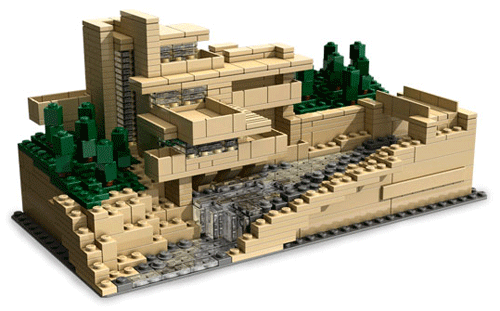
I’ve previously purchased and assembled all the other (smaller, much cheaper) kits in the architecture series, and had been very impressed both by how such iconic buildings were summarized in so few bricks, and also by the clever tricks used to subvert the trap of visual pixelization – specifically, designer Adam Reed Tucker makes extensive use of pieces like these:
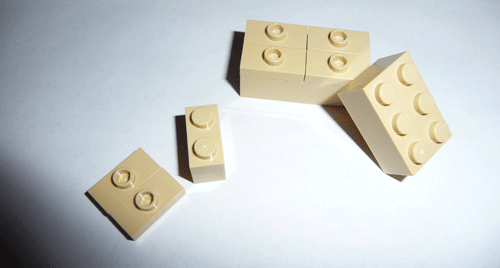
…to make connections like this:
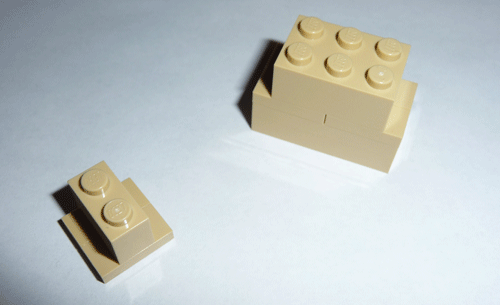
…which are halfway in between the two positions where standard brick connections would lie. This serves to double the pixel grid (and therefore, the resolution) the designer can work within. This is such a smart way to keep detail while avoiding high brick counts and cost-prohibitive kits.
While this is obviously a technique inherent in the standard brick designs – I had not seen it employed to such powerful effect before. The Empire State Building kit in particular is packed with clever connections like this. Ok, cool. Give me a second to pack up my nerd boner.
For those keeping score at home, the architecture series up to this point has featured:
- 21000 – Sears Tower (69 Bricks)
- 21001 – John Hancock Center (69 Bricks)
- 21002 – Empire State Building (77 Bricks)
- 21003 – Seattle Space Needle (69 Bricks)
- 21004 – Solomon R. Guggenheim Museum (208 Bricks, Frank Lloyd Wright Series)
- 21005 – Fallingwater (811 Bricks, Frank Lloyd Wright Series)
As the list above illustrates, the brick counts (and pricetags) have been steadily creeping up, and I had yet to rationalize to myself the benefits of laying out the cash for the Fallingwater kit – so I was super excited to receive it as a gift.
I tore into it pretty quickly, but took my time putting it together, doing a few pieces here and there whenever I walked by over the course of my time off around the holidays.
On the eve of heading back into work, I’ve finished the model, and it definitely gets my recommendation. While the expanded brick count and resolution meant that designer Tucker didn’t have to resort to half-scale brick tricks as on some of the other architecture kits – there are some really terriffic touches to this set that set it apart. Some of the things that I really liked about it:
1.) Assembling this kit really made me wake up to why people are always freaking out about the design of Fallingwater. Up until now, I’ve been operating in “OK, I GET IT! FRANK LLOYD WRIGHT! FALLING WATER! WALL CALENDAR EVERY YEAR, COOL SIGNATURE. I GET IT! ENOUGH ALREADY!” mode. Actually constructing all the asymmetric outcroppings and fitting them together to form the final design is a great experience, and this opened my eyes to yet another learning experience that legos can offer: the closer study of celebrated designs.
2.) The uncommon detail in the landscape, providing all the variance of elevation and detail of water, cobble, grass, and trees while finding the right balance between support and the hollowing of the base (Saving brick cost). It’s also interesting (to me, at least) that all of this landscape detail was achieved at smaller than ‘standard’ lego landscape scale.
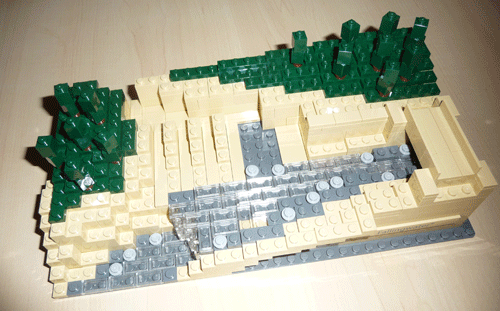
3.) The point where I first realized that the building and landscape bits would slide together but be removable was pretty nice, but when I realized each of the floors of the building proper were built modularly – to slide apart and back together easily without ‘unsticking’ any bricks – was when I really appreciated the attention to detail that went into this design.
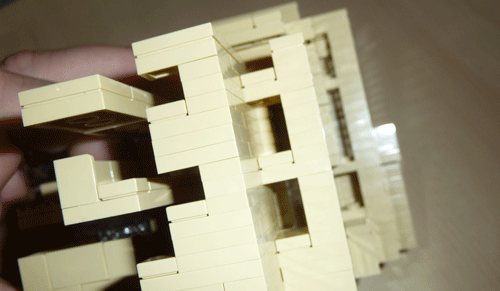
So to answer the question Sarah posed as she walked by the mess of tan bricks littering our kitchen table earlier in the week, was all that worth it? Yes! And thank you!
—
As an aside, this is a part of an attempt to post some bit of personal writing at least once a week in 2010. I’m going to start out by writing about things that have been piling up around me to see if I can remember how to write and then take it from there. We’ll see how it goes!
One of the insane revelations I had while writing this is that kids are reviewing lego kits (and toys in general) on youtube. For some reason, it never dawned on me that this was occurring, but I love that it is. Is that toy any good? Check youtube, and a few 12-year-olds will let you know.